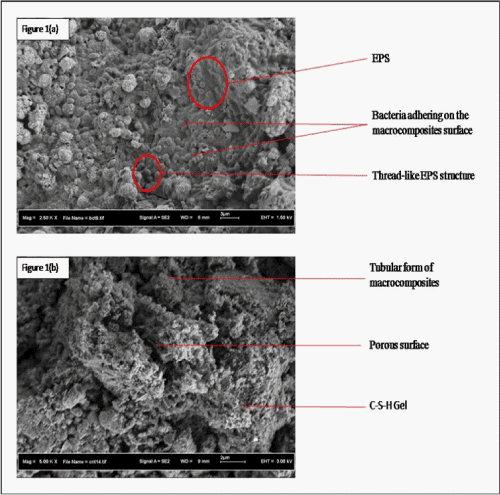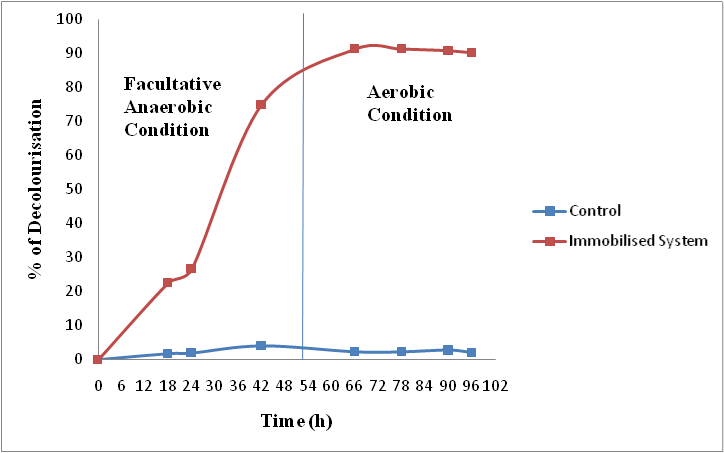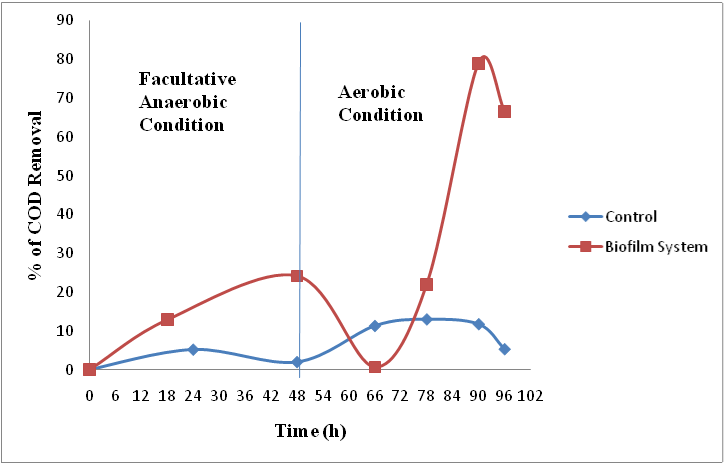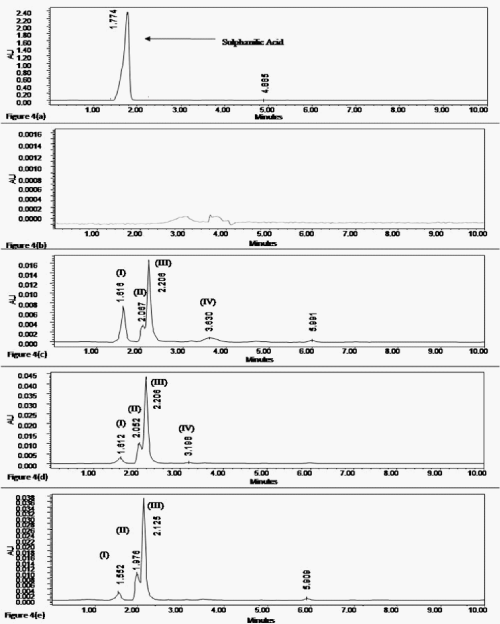Special Issue Article Open Access
Decolourisation of Reactive Black 5 Using paenibacillus sp. Immobilised Onto Macrocomposite
| Chi Kim Lim, Hui Han Bay, Thuan Chien Kee, Zaiton Abdul Majid and Ibrahim Zaharah* | |
| Universiti Teknologi Malaysia 81310, Skudai, Johor, Malaysia | |
| Corresponding Author : | Ibrahim Zaharah Faculty of Bioscience and Bioengineering Biology Department, Universiti Teknologi Malaysia 81310 Skudai, Johor, Malaysia E-mail: zaharahibrahim@utm.my |
| Received: September 16, 2011; Accepted: December 16, 2011; Published: December 18, 2011 | |
| Citation: Lim CK, Bay HH, Kee TC, Majid ZA, Zaharah I (2011) Secolourisation of Reactive Black 5 Using paenibacillus sp. Immobilised Onto Macrocomposite. J Bioremed Biodegrad S1:004. doi:10.4172/2155-6199.S1-004 | |
| Copyright: © 2011 Lim CK, et al. This is an open-access article distributed under the terms of the Creative Commons Attribution License, which permits unrestricted use, distribution, and reproduction in any medium, provided the original author and source are credited. | |
Related article at Pubmed Pubmed  Scholar Google Scholar Google |
|
Visit for more related articles at Journal of Bioremediation & Biodegradation
Abstract
Azo dyes account for one of the major source of dye wastes in textile effluent. In this study, macrocomposites used in the treatment of a reactive dye, Reactive Black 5 or RB5 is a combination of physical and biological method. Macrocompositee were developed by mixing zeolite, activated carbon and cement as a binder to produce porous composites of high compressive strength. It is capable of physical removal of RB5 from solution besides providing surfaces for the attachment and growth of the bacteria, Paenabacillus sp. as biofilm. The efficiency of the system was investigated in the presence and the absence of biofilm (control) in terms of decolourisation and COD removal. Results indicated that the biofilm system showed an overall better treatment efficiency than the control. The biofilm system successfully decolourized the Reactive Black 5 up to 91% (initial value of 100 mg/mL) as compared to the control which only showed decolourisation of about 4%. Besides that, the biofilm system was also effective in reducing COD value from 898 mg/L to 188 mg/L (79%), while only 13% that of the control. High Performance Liquid Chromatography (HPLC) analyses showed the formation of sulphanilic acid (SA) as a possible degradation product of RB5 under anaerobic condition.
| Keywords |
| Reactive Black 5; Decolourisation; Paenibacillus sp.; Biofilm; HPLC |
| Introduction |
| Azo dyes represent a major group of synthetic organic compounds which are extensively used in textile dyeing and many other industries. These dyes are known to be xenobiotic and are often recalcitrant to biodegradation processes. Although the dyes impart only a minor fraction of organic load, colour removal is required not only for aesthetic reasons but also due to the toxicity, mutagenicity and carcinogenicity of their degradation products [1]. There are numerous techniques used to treat textile industrial wastewater and can be classified into physical, chemical and biological approaches. Physical and/or chemical processes are more widely used due to their generally faster treatment rate than that of biological methods. These technologies, however, are mostly not feasible due to the complex procedures involved [2]. Some may even generate toxic sludge which requires further disposal [3]. Biological treatment processes which lead to mineralisation of azo dyes into simpler inorganic compounds which are not harmful to life forms, on the other hand, provide effective and environmental friendly treatment process at a lower cost [4]. |
| The study aimed to demonstrate the potential of an alternative option for treating textile dyes utilising macrocomposites that have been carefully formulated to produce macrocomposite of superior physical and chemical properties. This will be then be used as “housing” or attachment of bacterial film, Paenibacillus sp. for the removal and possible degradation of azo dye, Reactive Black 5 (RB5) which is widely used for dyeing in textile industries [5]. |
| Materials and Methods |
| Microorganism |
| Locally isolated bacterial strain, Paenibacillus sp. was obtained from the stock cultures of the Research Laboratory II, Faculty of Biosciences and Bioengineering, Universiti Teknologi of Malaysia [6]. |
| Medium preparation |
| All chemicals used in this study were of analytical grade. The Reactive Black 5 (RB5) dye was purchased from Sigma-Aldrich® Inc. Synthetic medium called Chemically Defined Medium (CDM) consisted of K2HPO4 (7g/L), KH2PO4 (2g/L), MgSO4.7H2O (0.1g/L), (NH4)2SO4 (1g/L) and CaCl2 (0.02 g/L) was adjusted to pH 7.0 ± 0.2 prior to autoclaving at 121Ã?Â?C, 1.5 kPa for 15 minutes. The glycerol (0.1% v/v) and the RB5 dye (100ppm) were filter sterilized. |
| Development of macrocomposite |
| The best mix ratio design for the macrocomposite was developed by mixing zeolite, activated carbon and cement. The mixture was placed into moulds and left overnight to dry. Following that, the hardened macrocomposite were immersed in water to strengthen its structure. |
| Formation of biofilm on macrocomposite |
| The bacterial inoculum was prepared by growing the bacteria overnight at 37Ã?Â?C and transferring 10% (v/v) into RB5 dye solution enriched with CDM and glycerol. The macrocomposites were used as support matrix for the biofilm formation. The formation of biofilm was examined using the Field Emission Scanning Electron Microscope (FESEM). |
| Decolourisation analysis |
| The macrocomposites were placed into vessel containing RB5 solution and CDM. For the treatment of RB5 dye solution, a sequential anaerobic-aerobic process was recommended [7]. The culture was incubated at 37Ã?Â?C under non-shaking condition for 48 hours. At the end of 48 hours incubation, aeration was introduced into cultures for another 48 hours. During these 96 hours of sequential anaerobicaerobic treatment, samples were drawn out at regular time interval before centrifuged at 4000 rpm for 15 minutes. The supernatants were separated and colour was measured at the maximum absorption wavelength for RB5 dye. Similarly, macrocomposite without biofilm was used as control. The percentage of decolourisation was determined from the following equation: |
| Decolourisation (%) = ((Initial absorbance - Sample absorbance)/Initial absorbance) X 100% |
| Chemical Oxygen Demand (COD) analysis |
| Chemical oxygen demand (COD) was determined as described in HACH manual (HACH, 1997). |
| Analysis of RB5 degradation products by High Performance Liquid Chromatography (HPLC) |
| Extraction of degradation products was carried out based on procedures described by [8]. All filtered samples were eluted isocratically at flow rate 0.7 mL min-1 using Hypersil C18 column (5 μm, 4.6 mm x 250 mm, Waters). Mixture of methanol and nano pure water in the ratio of 7:3 (v/v) was used as the mobile phase. |
| Results and Discussion |
| Development of macrocomposite |
| The best mix ratio design for the macrocomposite was determined from the compressive strength value which will ensure that it would not disintegrate due to stress and shear force. Macrocomposite with high porosity would provide large surface area for biofilm formation. Hence, selection of the macrocomposite to be used in the study was based on its high porosity and compressive strength. |
| Development of biofilm on macrocomposite |
| The macromposite that was developed in this study is shown in the FESEM micrograph (Figure 1a). Generally the morphology of the surfaces of the composite is highly porous with C-S-H gels which resulted from the chemical reaction between zeolite composite and cement (calcium hydroxide). Tubular form of the macrocomposite was also commonly observed. In contrast, growth of Paenibacillus sp. onto the macrocomposite (Figure 1b) showed evidence of biofilm formation; the surfaces appeared to be covered with a thin layer of substances which allow cells underneath to be observed. These are often associated to the presence of EPS [9]. For attached growth or immobilization of bacteria onto the composite surfaces, EPS produced may also appear as thread-like or web-like (bioweb) structures. |
| Decolourisation analysis |
| During the anaerobic phase of the combined facultative anaerobicaerobic treatment system, RB5 dye treated with biofilm system was decolourised up to 91% while 4% of decolourisation was found for the control (Figure 2). It was also found maximum decolourisation was achieved during the facultative anaerobic phase (80%) as compared to the aerobic phase (10%). According to Jang et al. [10], decolourisation of Reactive Black 5 worked best under facultative anaerobic condition. A plausible explanation is the formation of an ‘oxygen depletion’ state by microbial film which proved critical for the decolourisation of azo dyes. Bacterial decolorization of azo dyes is normally inhibited in the presence of oxygen primarily due to competition for electrons from reduced electron carriers (e.g. NADH) with either oxygen or azo groups as the electron receptor [11]. The slight drop in decolourisation of 89 % during the aerobic phase was probably due to the aeration which in the presence of oxygen induces the reaction of decolourised intermediates via autoxidation reaction of the aromatic amines to produce new oxidized intermediate products [12]. |
| Chemical Oxygen Demand (COD) analysis |
| The results for the total COD removal of the combined facultative anaerobic/aerobic treatment system as shown in Figure 3 was six (6) fold higher during aerobic phase in the presence of biolfim (79%) as compared to the control (13%). This was probably due to the ability of the acclimatized bacterial film to degrade organic pollutant in RB5 dye and the adsorption of inorganic and organic compounds by the macrocomposites. In addition, both the biofilm and the control exhibited higher total COD removal under aerobic condition as compared to the facultative anaerobic condition. This may be attributed to the bacteria oxidising the organic compounds for carbon and energy source under aerobic condition; similar observations were also reported by other researchers involved in the biological treatment of azo dyes [13-15]. It should be noted that the amount of glycerol added to the culture medium makes it a major contributor to COD. It is anticipated that glycerol is mainly used as a co-substrate for cellular growth and subsequently lead to increase in biomass resulting in significant removal of COD during the aerobic process. |
| Analysis of biodegradation products using HPLC |
| During the 96 hours of sequential anaerobic-aerobic treatment process, possible biodegradation products were analysed using HPLC. At the beginning of the anaerobic incubation, (Figure 4b; t= 0) no visible peak was observed. However, at t= 24 hours, peak I with retention time of about 2 min was observed in Figure 4c and this corresponded to that of standard sulphanilic acid (Figure 4a). Subsequent similar but smaller peaks were also detected after 48 h of incubation under facultative anaerobic condition (Figure 4d) which may imply reduced concentration of sulphanilic acid during the anaerobic treatment. The concentration of peak I was gradually reduced to 0.03 mgL-1 at final aerobic phase of treatment (Figure 4e). This is possible since sulphanilic acid is one of the decolourisation metabolites that can be produced during reduction of RB5 under facultative anaerobic stage. Furthermore, in this treatment system, the depletion of sulphanilic acid was mainly due to the bacterial degradation as well as physical absorption by the macrocomposite. Under the aerobic condition however, sulphanilic acid might be mineralized, or autoxidised and biotransformed to other possible intermediates [16]. Peaks (II), (III) and (IV) could possibly be the products of auto-oxidation, which may resulted from decolourised metabolites undergoing biodegradation or auto-oxidation reaction under subsequent aerobic treatment. |
| Conclusion |
| Sequential facultative anaerobic-aerobic decolourisation of azo dye RB5 using Paenibacillus sp. in the form of biofilm was effective for the decolourisation (91%) and removal of COD (79%). Further analysis using the HPLC suggested that the biofilm system was able to degrade RB5 to decolourised metabolites such as sulphanilic acid (aromatic amines). Intensive research is currently in progress to elucidate mechanisms of degradation and auto-oxidation of decolourised metabolites under aerobic condition. |
| Acknowledgements |
| The first author would like to thank MOSTI, Malaysia for awarding him the National Science Foundation Scholarship. The second author would like to extend her gratitude to the Universiti Teknologi Malaysia and the Ministry of Higher Education of Malaysia for awarding her the Zamalah Scholarship and the third author would like to acknowledge Kuok Foundation Berhad, Malaysia for awarding him the Kuok Foundation Postgraduate Scholarship. |
References
|
Figures at a glance
 |
 |
 |
 |
| Figure 1 | Figure 2 | Figure 3 | Figure 4 |
Relevant Topics
- Anaerobic Biodegradation
- Biodegradable Balloons
- Biodegradable Confetti
- Biodegradable Diapers
- Biodegradable Plastics
- Biodegradable Sunscreen
- Biodegradation
- Bioremediation Bacteria
- Bioremediation Oil Spills
- Bioremediation Plants
- Bioremediation Products
- Ex Situ Bioremediation
- Heavy Metal Bioremediation
- In Situ Bioremediation
- Mycoremediation
- Non Biodegradable
- Phytoremediation
- Sewage Water Treatment
- Soil Bioremediation
- Types of Upwelling
- Waste Degredation
- Xenobiotics
Recommended Journals
Article Tools
Article Usage
- Total views: 14456
- [From(publication date):
specialissue-2012 - Apr 26, 2025] - Breakdown by view type
- HTML page views : 9806
- PDF downloads : 4650
